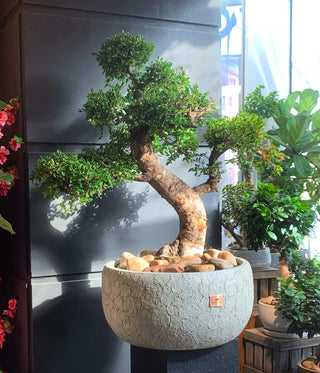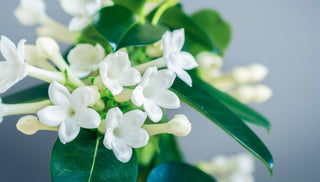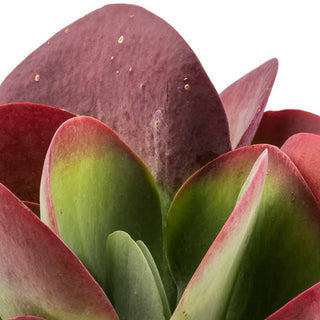☘ Origin: Eastern Asia
☘ Family: Ulmaceae - Elm
☘ Botanical Name: Ulmus parvifolia
☘ Common Name: Chinese Elm
Symbolism: Chinese Elm is a symbol of balance, love, and peace. Chinese Elms represent:
- Harmony – The Chinese Elm is considered the “Tree of Harmony” because it symbolizes inner strength, wisdom, and intuition.
- Love – The Chinese Elm represents love in a way that is calm, balanced, and brings peaceful energy.
Bonsai meanings are very important when gifting your tree to someone. Bonsai symbolize harmony, peace, an order of thoughts, balance and all that is good in nature. Every time your giftee looks at their tree, they will be reminded of its special significance.
🍃 Shop Your Chinese Elm Bonsai Today!
🔆 Light
The Chinese Elm thrives in direct sunlight. Depending on winter temperatures, Chinese Elms either drop their leaves or keep them until spring when the new shoots emerge.
If your home does not receive enough natural light, you can use artificial lighting in the form of fluorescent or LED grow lights. Position the lights above the tree at least (30cm) away from its foliage and keep them on for about (14-16) hours per day.
💧 Water
The Chinese Elm can not tolerate prolonged drought or constant moisture. Ignore labels stating your Chinese Elm needs watering every day, you need to water on observation. Wait until the top soil is dry, and then water generously, making sure the entire root-mass is watered.
Aim to maintain an even level of moisture. Balance is key. You can rot plants roots through too much water. Equally too little water has more obvious consequences. If the leaves curl up, go dry and crispy, this is a sign of drying out.
Indoors, the most simple way to water is with a cup or jug. Just pour water onto the soil surface. Water until water runs out of the holes in the bottom of the pot. Most of the roots are in the bottom portion of the pot, so if you only give them a bit of water, the top will look wet, while the majority of the roots are actually dry.
To give your plant the absolute best, room-temperature rainwater and bottled spring water are your best options. Any water containing sugar or salt will hurt your plant!
☁️ Humidity
Leaves needs humidity to keep them green and healthy, and appreciate regular misting using filtered-water.
🌡️ Temperature
The Chinese Elm Bonsai is hardy and can handle a wide range of temperatures, but It has its limits. In general, Chinese Elm prefers moderate room temperatures between (16-24°C).
When the temperature drops below (10°C), it can cause stress to the tree and slow down its growth. If you live in a region with cold winters, it’s best to keep your Chinese Elm Bonsai in room temperature indoors. On the other hand, extreme heat can also be detrimental to your Bonsai’s health. If the tree stays in an environment that is too hot, the leaves will begin to dry out and the tree will begin to decline in health.
🧴️ Food
Make sure to fertilize often to nourish your Chinese Elm during the growing season. You don't need to use any fancy fertilizers. A solid organic fertilizer, or a well-balanced liquid chemical fertilizer works great. No fertilization is necessary during cold winters when the Elm tree is dormant.
Another option would be to feed your Bonsai with a plant food that is specifically formulated for Bonsai trees. This ensures your tree gets all the nutrients it needs in smaller doses that are easier for your tree to use.
✂️ Pruning
Will you have to prune it? The answer is most definitely yes. Don’t worry, its a good thing! The most simple answer to the question how to prune your Chinese Elm Bonsai is to let each shoot grow to a couple of inches and then to prune back to the first four leaves. You’ll notice that they start off quite small and get progressively bigger as the new shoot grows.
You are usually aiming to maintain the existing shape, Ex. a triangle shape with a dome crown. anything that breaks this shape can be removed. Furthermore, any shoots that grow downwards can be removed. Trees in nature don’t tend to do that.
You want your Chinese Elm Bonsai to get bigger and better over time. So how can this happen? that it won’t magically expand or rise over time. Instead, the pruning is like topiary - you carefully prune the tree allowing bits of growth to continue in the way that you want it to.
The aim of the game is often to increase the twiggyness of the Bonsai tree, rather than the height. Think about it - one cut shoot generally leads to two smaller side shoots, which when cut lead to four smaller shoots.
🐛 Pests and Diseases
The Chinese Elm is often infested by spider mites or scale when humidity is low. Appropriate pesticides should be used, and frequent spraying with water helps to deter pests and diseases. Spraying with thinned lime-sulfur or systemic pesticides can cause the Chinese Elm to lose all its leaves, so avoid these products.
🐾 Toxicity
The Chinese Elm is mildly toxic. It is not dangerous to larger animals such as horses and cattle at all. The tree also poses no risk to birds. Dogs and cats should be kept away from your Chinese Elm so they are not tempted to nibble the leaves or gnaw at the bark.



